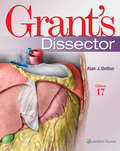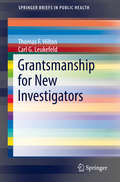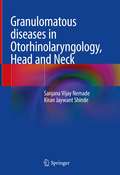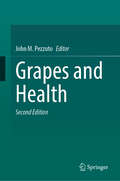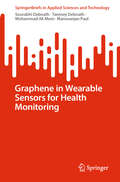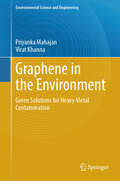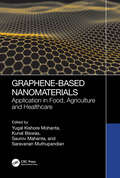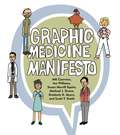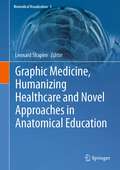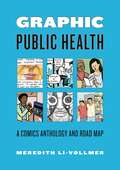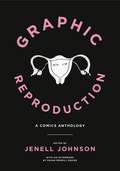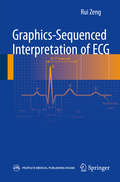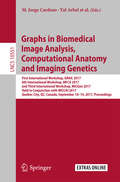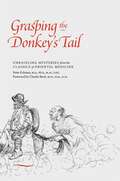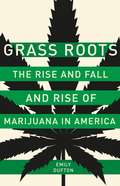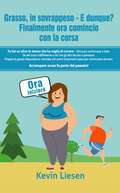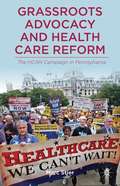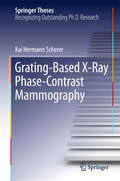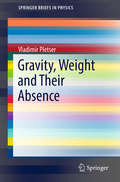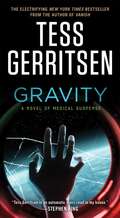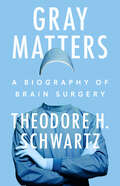- Table View
- List View
Grant's Dissector (Lippincott Connect Ser.)
by Alan J. DettonGrant’s Dissector, Seventeenth Edition provides step-by-step human cadaver dissection procedures for students to perform in the anatomy lab and to recognize important relationships revealed through dissection. More informative and approachable than ever, this updated seventeenth edition broadens students’ understanding of key dissection procedures and readies them for success in healthcare practice. Each chapter is consistently organized beginning with a Dissection Overview that provides a blueprint of what needs to be accomplished during the dissection session and includes relevant surface anatomy. Dissection Instructions offer a logical sequence and numbered steps for the dissection. The Dissection Follow-up emphasizes important features of the dissection and encourages students to reflect on and synthesize the information.
Grantsmanship for New Investigators (SpringerBriefs in Public Health)
by Carl G. Leukefeld Thomas F. HiltonThis compact resource analyzes and demystifies the processes of applying for, competing for, and getting funding for research. Neither a cookbook nor a template, it encourages readers to apply the critical thinking and attention to detail they use in their investigations to the pursuit of the grant. Chapters delve into choosing among funding options, project planning and writing, filling out the materials in the application packet, and troubleshooting for problems at various steps of the journey. Along the way, the authors also explore common myths of grantsmanship and alert readers to hidden pitfalls that can get an otherwise good submission rejected. Among the core skill areas covered: · Using strategic thinking throughout the application process · Understanding the major grant mechanisms · Navigating the grant timeline, including the peer review and the vetting process · Writing the effective project description · Following up if the project is not funded or funding is deferred · Building a career grant by grant Brimming with expert knowledge, Grantsmanship for New Investigators ably balances motivation with realism. The authors’ deep understanding and experience of how funding agencies arrive at judgments will inspire readers to present their research in the most convincing manner.
Granulomatous diseases in Otorhinolaryngology, Head and Neck
by Sanjana Vijay Nemade Kiran Jaywant ShindeThis book provides the description of the granulomatous diseases of otorhinolaryngology, head and neck with their characteristic features, investigations and management. It includes wide variety of infective, idiopathic, neoplastic, hereditary, reactive and various other types of chronic granulomatous reaction in the ear, nose, throat and head neck region. Further, the description is supported with various illustrations including clinical photographs, radiological pictures of CT scan, MRI scan etc. Histopathological and microbiological images which show characteristics and differentiating features are also included to aid in the diagnosis of the diseases. Histopathological colored images with high magnification and immunohistochemistry images are provided for better illustrations. This book also elaborates the important medical and surgical management of the granulomatous diseases. Every chapter ends with the ‘Essential features’ of that particular granulomatous disease, and this will certainly help the post-grad students and clinicians to differentiate the diseases, early diagnosis and management of the patients with chronic granulomatous diseases.
Grapes and Health
by John M. PezzutoSince the publication of the first edition of Grapes and Health, much research funding has been invested in the further examination of the health-promoting benefits of grapes, exploring areas such as brain health, eye and heart health, as well as more novel areas such as skin health and microbiomics. The wide scope and diversity of the research on grapes and their benefits for human health suggests the necessity of a comprehensive and up-to-date overview of the subject. Updating and expanding on its first edition, Grapes and Health (2nd ed.) accounts for the increased use of human trials in researching the effects of grapes on health, thereby demonstrating even more directly the diverse benefits that this fruit can offer the average person by inclusion into their diet. This volume recognizes the power of eating real, simple foods for lasting health-promoting and disease-preventing effects. Experts across the fields of nutrition, microbiomics, pharmacology and more offer their insights into the various mechanisms by which grapes can bolster health and nutrition, improving quality of life and longevity. In Grapes and Health (2nd ed.), food science researchers, grape growers and health professionals alike will find a guide to the varied and complex ways in which this one food item can impact the body. Consumers, meanwhile, will discover a new perspective on this commonplace but often overlooked staple of their diet.
Graph Neural Network for Hyperspectral Image Clustering (Intelligent Perception and Information Processing)
by Jie Feng Yao Ding Zhili Zhang Haojie Hu Renxiang Guan Zhiyong LvThis book investigates detailed hyperspectral image clustering using graph neural network (graph learning) methods, focusing on the overall construction of the model, design of self-supervised methods, image pre-processing, and feature extraction of graph information. Multiple graph neural network-based clustering methods for hyperspectral images are proposed, effectively improving the clustering accuracy of hyperspectral images and taking an important step towards the practical application of hyperspectral images. This book is innovative in content and emphasizes the integration of theory with practice, which can be used as a reference book for graduate students, senior undergraduate students, researchers, and engineering technicians in related majors such as electronic information engineering, computer application technology, automation, instrument science and technology, remote sensing.
Graphene in Wearable Sensors for Health Monitoring (SpringerBriefs in Applied Sciences and Technology)
by Manoranjan Paul Mohammad Ali Moni Sourabhi Debnath Tanmoy DebnathThis book highlights the advancement of graphene-based non-invasive sensors for health monitoring. Graphene has been considered the strongest and thinnest known material to date. Unlike most semiconductor systems, its two-dimensional (2D) electronic state can be accessed directly by tunneling or other local probes. With their mechanical, thermal, and electrical properties, graphene-based materials have shown effectiveness in sensing various biophysical and biochemical signals such as body temperature, heart rate, respiration rate, blood pressure, blood glucose levels and electrocardiograms, electromyograms, and electroencephalograms.
Graphene in the Environment: Green Solutions for Heavy Metal Contamination (Environmental Science and Engineering)
by Virat Khanna Priyanka MahajanThis book explores the use of graphene in heavy metal cleanup. The introductory chapter contains enough information for understanding graphene, including its synthesis, characterisation, and amazing mechanical, electrical, and thermal properties. The risks of compounds like lead, mercury, cadmium, and arsenic are also explained, along with the dangerous effects of heavy metals. The next chapters go into great detail about the ways by which graphene expertly adsorbs heavy metal ions. The ability of graphene to absorb heavy metals and the extraordinary adsorption characteristics that explain graphene&’s efficiency in heavy metal removal are well explained. This book also shows how graphene may be dynamically combined with other materials to create potent nanocomposites with improved heavy metal cleanup capabilities. The environmental and safety implications of these ground-breaking solutions are also well given in detail. In addition to discussing the potential environmental issues associated with the discharge of graphene particles, the complexity of graphene dispersion, scalability, and cost-effectiveness are also covered. This book ends by looking towards the future prospects of how graphene will change its role in heavy metal cleaning and continue to advance in the same domain. This book is an attempt to explore a cutting-edge area of materials science and environmental protection. It connects the extraordinary qualities of graphene, and heavy metal contamination in pursuit of a cleaner environment and is a good resource for scholars, academicians, and environmental practitioners by revealing a thorough examination of the crucial part that graphene plays in tackling heavy metal contamination.
Graphene-Based Nanomaterials: Application in Food, Agriculture and Healthcare
by Yugal Kishore Mohanta Saurov Mahanta Kunal Biswas Saravanan MuthupandianThe book presents a comprehensive overview of the historical, current, and prospective application realms of nanobiotechnological research pertaining to graphene, a carbon-based nanomaterial, and its diverse forms in the fields of food and agriculture, as well as health sciences and technology. Young nanotechnologists and businesses will have access to nanobioanalytical methods. Given the present circumstances, it is crucial to underscore the potential ramifications that diverse forms of graphene nanomaterials could have on the food sector, agricultural methodologies, and healthcare. This book presents an analysis of the potential advantages of graphene-based nanomaterials over traditional materials in the food, agriculture, and health care sectors. This book employs case studies, academic and theoretical literature, technology transfer, innovation, economics, and policy management to underscore the intricate issues associated with graphene nanomaterials. The pioneering text Graphene-Based Nanomaterials: Application in Food, Agriculture, and Healthcare has the potential to serve as a valuable resource for interdisciplinary researchers, academics, practitioners, policymakers, and professionals operating within the fields of science, technology, engineering, innovation, management, and economics. Features · Discusses the different aspects of graphene as a two-dimensional material and its underlying unique physicochemical properties, synthesis methods, and protocols. · Considers the implications of graphene in the food sciences and its different spoilage detection mechanisms have been encompassed in the book. · Explores graphene nanomaterials' medical and biomedical uses. With examples, the unique and tailor-made material's uses and prospects in health sciences, pharmaceutics, and biomedical research are highlighted. · Elaborates on graphene's applications in agriculture and briefs the potential of biocompatible planar conductive nanoscale materials to boost agri-product production, crop development, and crop-infection surveillance.
Graphic Medicine Manifesto (Graphic Medicine #1)
by Ian Williams Michael J. Green Susan Merrill Squier Scott T. Smith MK Czerwiec Kimberly R. MyersThis inaugural volume in the Graphic Medicine series establishes the principles of graphic medicine and begins to map the field. The volume combines scholarly essays by members of the editorial team with previously unpublished visual narratives by Ian Williams and MK Czerwiec, and it includes arresting visual work from a wide range of graphic medicine practitioners. The book’s first section, featuring essays by Scott Smith and Susan Squier, argues that as a new area of scholarship, research on graphic medicine has the potential to challenge the conventional boundaries of academic disciplines, raise questions about their foundations, and reinvigorate literary scholarship—and the notion of the literary text—for a broader audience. The second section, incorporating essays by Michael Green and Kimberly Myers, demonstrates that graphic medicine narratives can engage members of the health professions with literary and visual representations and symbolic practices that offer patients, family members, physicians, and other caregivers new ways to experience and work with the complex challenges of the medical experience. The final section, by Ian Williams and MK Czerwiec, focuses on the practice of creating graphic narratives, iconography, drawing as a social practice, and the nature of comics as visual rhetoric. A conclusion (in comics form) testifies to the diverse and growing graphic medicine community. Two valuable bibliographies guide readers to comics and scholarly works relevant to the field.
Graphic Medicine Manifesto (Graphic Medicine)
by Ian Williams Michael J. Green Susan Merrill Squier Scott T. Smith MK Czerwiec Kimberly R. MyersThis inaugural volume in the Graphic Medicine series establishes the principles of graphic medicine and begins to map the field. The volume combines scholarly essays by members of the editorial team with previously unpublished visual narratives by Ian Williams and MK Czerwiec, and it includes arresting visual work from a wide range of graphic medicine practitioners. The book’s first section, featuring essays by Scott Smith and Susan Squier, argues that as a new area of scholarship, research on graphic medicine has the potential to challenge the conventional boundaries of academic disciplines, raise questions about their foundations, and reinvigorate literary scholarship—and the notion of the literary text—for a broader audience. The second section, incorporating essays by Michael Green and Kimberly Myers, demonstrates that graphic medicine narratives can engage members of the health professions with literary and visual representations and symbolic practices that offer patients, family members, physicians, and other caregivers new ways to experience and work with the complex challenges of the medical experience. The final section, by Ian Williams and MK Czerwiec, focuses on the practice of creating graphic narratives, iconography, drawing as a social practice, and the nature of comics as visual rhetoric. A conclusion (in comics form) testifies to the diverse and growing graphic medicine community. Two valuable bibliographies guide readers to comics and scholarly works relevant to the field.
Graphic Medicine, Humanizing Healthcare and Novel Approaches in Anatomical Education (Biomedical Visualization #3)
by Leonard ShapiroThis book contains subjects by authors with a fresh, exciting and extensive focus within the medical humanities, offering the reader chapters which include the history of medical illustration, Graphic Medicine as a vehicle for the expression of humanistic dimensions of healthcare, equitable and ethical medical illustrations, as well as novel, art-based approaches in anatomical education. Authors consider the role of visual narratives in medical and scientific illustration, the unique affordances of the comics medium, the history of comics as a form of medical and scientific visualization, and the role of comics as didactic tools and as vehicles for the expression of the humanistic dimensions of healthcare. A chapter considers ethical and equitable implications in global healthcare practice, and highlights the work currently being undertaken to address inappropriate and problematic depictions of people in global health visualizations. This will inform the reader of emerging and current thinking about visual communication and the use of images in the public domain, as well as in the healthcare and education sectors. Novel approaches in anatomical education include the benefits of three-dimensional anatomy models made of felt, visual analogies as a method to enhance students’ learning of histology, the use of the hands for learning anatomy, and visualizing anatomy through art, archaeology and medicine. This book will appeal to readers who have an interest in the medical humanities, Graphic Medicine, and ethical medical and anatomical illustrations. These include academic and non-academic readers, medical students, medical educators, clinicians, health-care workers, as well as policy makers.
Graphic Public Health: A Comics Anthology and Road Map (Graphic Medicine)
by Meredith Li-VollmerAs we confront the challenges of emerging diseases, environmental health threats, and gaps in health equity, medical professionals need versatile communication tools that help people make informed decisions and engage them in constructive conversations about the health of their communities. This book illuminates the power of comics to meet that need.Graphic Public Health demonstrates the range and potential of comics to address topics such as immunization promotion, outbreak prevention, gun violence, opioid addiction prevention, and climate change. It features the work of acclaimed cartoonists Ellen Forney, David Lasky, and Roberta Gregory, pieces by up-and-coming artists, and comics that Meredith Li-Vollmer produced as a communications specialist for Seattle’s public health department. More than a collection of cartoons, this book connects comics with fundamentals of health communication and discusses why the form can be uniquely effective for these purposes. Each chapter focuses on the use of graphic public health in the context of four specific goals: health literacy, risk communication, health promotion, and advocacy. Li-Vollmer also includes guidance for practitioners getting started in creating comics for any form of public information, and especially for public health.Practical and purposeful, Graphic Public Health is a clarion call for the current era and an invaluable resource for public health professionals and advocates, scholars of comics and graphic studies, and fans of the graphic medicine genre.
Graphic Reproduction: A Comics Anthology (Graphic Medicine #11)
by Susan Merrill Squier Jenell JohnsonThis comics anthology delves deeply into the messy and often taboo subject of human reproduction. Featuring work by luminaries such as Carol Tyler, Alison Bechdel, and Joyce Farmer, Graphic Reproduction is an illustrated challenge to dominant cultural narratives about conception, pregnancy, and childbirth.The comics here expose the contradictions, complexities, and confluences around diverse individual experiences of the entire reproductive process, from trying to conceive to child loss and childbirth. Jenell Johnson’s introduction situates comics about reproduction within the growing field of graphic medicine and reveals how they provide a discursive forum in which concepts can be explored and presented as uncertainties rather than as part of a prescribed or expected narrative. <P><P>Through comics such as Lyn Chevley’s groundbreaking “Abortion Eve,” Bethany Doane’s “Pushing Back: A Home Birth Story,” Leah Hayes’s “Not Funny Ha-Ha,” and “Losing Thomas & Ella: A Father’s Story,” by Marcus B. Weaver-Hightower, the collection explores a myriad of reproductive experiences and perspectives. The result is a provocative, multifaceted portrait of one of the most basic and complicated of all human experiences, one that can be hilarious and heartbreaking.Featuring work by well-known comics artists as well as exciting new voices, this incisive collection is an important and timely resource for understanding how reproduction intersects with sociocultural issues. The afterword and a section of discussion exercises and questions make it a perfect teaching tool. <P><P> <i>Advisory: Bookshare has learned that this book offers only partial accessibility. We have kept it in the collection because it is useful for some of our members. Benetech is actively working on projects to improve accessibility issues such as these.</i>
Graphic Reproduction: A Comics Anthology (Graphic Medicine)
by Susan Merrill SquierThis comics anthology delves deeply into the messy and often taboo subject of human reproduction. Featuring work by luminaries such as Carol Tyler, Alison Bechdel, and Joyce Farmer, Graphic Reproduction is an illustrated challenge to dominant cultural narratives about conception, pregnancy, and childbirth.The comics here expose the contradictions, complexities, and confluences around diverse individual experiences of the entire reproductive process, from trying to conceive to child loss and childbirth. Jenell Johnson’s introduction situates comics about reproduction within the growing field of graphic medicine and reveals how they provide a discursive forum in which concepts can be explored and presented as uncertainties rather than as part of a prescribed or expected narrative. Through comics such as Lyn Chevley’s groundbreaking “Abortion Eve,” Bethany Doane’s “Pushing Back: A Home Birth Story,” Leah Hayes’s “Not Funny Ha-Ha,” and “Losing Thomas & Ella: A Father’s Story,” by Marcus B. Weaver-Hightower, the collection explores a myriad of reproductive experiences and perspectives. The result is a provocative, multifaceted portrait of one of the most basic and complicated of all human experiences, one that can be hilarious and heartbreaking.Featuring work by well-known comics artists as well as exciting new voices, this incisive collection is an important and timely resource for understanding how reproduction intersects with sociocultural issues. The afterword and a section of discussion exercises and questions make it a perfect teaching tool.
Graphics Processing Unit-Based High Performance Computing in Radiation Therapy (Series in Medical Physics and Biomedical Engineering)
by Xun Jia and Steve B. JiangUse the GPU Successfully in Your Radiotherapy Practice With its high processing power, cost-effectiveness, and easy deployment, access, and maintenance, the graphics processing unit (GPU) has increasingly been used to tackle problems in the medical physics field, ranging from computed tomography reconstruction to Monte Carlo radiation transport simulation. Graphics Processing Unit-Based High Performance Computing in Radiation Therapy collects state-of-the-art research on GPU computing and its applications to medical physics problems in radiation therapy. Tackle Problems in Medical Imaging and Radiotherapy The book first offers an introduction to the GPU technology and its current applications in radiotherapy. Most of the remaining chapters discuss a specific application of a GPU in a key radiotherapy problem. These chapters summarize advances and present technical details and insightful discussions on the use of GPU in addressing the problems. The book also examines two real systems developed with GPU as a core component to accomplish important clinical tasks in modern radiotherapy. Translate Research Developments to Clinical Practice Written by a team of international experts in radiation oncology, biomedical imaging, computing, and physics, this book gets clinical and research physicists, graduate students, and other scientists up to date on the latest in GPU computing for radiotherapy. It encourages you to bring this novel technology to routine clinical radiotherapy practice.
Graphics-sequenced interpretation of ECG
by Rui ZengThis book is intended for medical students unfamiliar with electrocardiograms (ECG); anyone just getting started with ECG can use this book to start from scratch. After familiarizing themselves with this simple and practical method for interpreting ECG, readers will discover how to quickly and easily read ECG strips without overlooking potentially abnormal conditions. Based on the authors' substantial experience, which is compared with other ECG interpretation methods and combined with traditional guidelines, the book equips readers with the fundamental knowledge and skills needed to rapidly and accurately read and interpret ECG.
Graphs in Biomedical Image Analysis, Computational Anatomy and Imaging Genetics: First International Workshop, GRAIL 2017, 6th International Workshop, MFCA 2017, and Third International Workshop, MICGen 2017, Held in Conjunction with MICCAI 2017, Québec City, QC, Canada, September 10–14, 2017, Proceedings (Lecture Notes in Computer Science #10551)
by M. Jorge Cardoso, Tal Arbel, Enzo Ferrante, Xavier Pennec, Adrian V. Dalca, Sarah Parisot, Sarang Joshi, Nematollah K. Batmanghelich, Aristeidis Sotiras, Mads Nielsen, Mert R. Sabuncu, Tom Fletcher, Li Shen, Stanley Durrleman and Stefan SommerThis book constitutes the refereed joint proceedings of the First International Workshop on Graphs in Biomedical Image Analysis, GRAIL 2017, the 6th International Workshop on Mathematical Foundations of Computational Anatomy, MFCA 2017, and the Third International Workshop on Imaging Genetics, MICGen 2017, held in conjunction with the 20th International Conference on Medical Imaging and Computer-Assisted Intervention, MICCAI 2017, in Québec City, QC, Canada, in September 2017.The 7 full papers presented at GRAIL 2017, the 10 full papers presented at MFCA 2017, and the 5 full papers presented at MICGen 2017 were carefully reviewed and selected. The GRAIL papers cover a wide range of graph based medical image analysis methods and applications, including probabilistic graphical models, neuroimaging using graph representations, machine learning for diagnosis prediction, and shape modeling. The MFCA papers deal with theoretical developments in non-linear image and surface registration in the context of computational anatomy. The MICGen papers cover topics in the field of medical genetics, computational biology and medical imaging.
Grasping the Donkey's Tail: Unraveling Mysteries from the Classics of Oriental Medicine
by Peter Eckman Charles BuckA scholarly yet practical account for modern clinicians of some of the key difficult questions arising from obscure passages in the classics of Chinese medicine. This book offers an interpretation of crucial sections from the classical Chinese texts which have continued to puzzle western clinicians, and serves as a basis for more effective acupuncture treatments. The author discusses Sasang medicine interpretations of specific phenomena, showing where Korean medicine diverged from Chinese, and how the two traditions can inform each other, and the modern acupuncturist. Elsewhere, he discusses the Daoist roots of Chinese medicine, the fundamental differences between Oriental and western medical approaches, as well as various important issues in pulse diagnosis, all of which have practical application for modern clinicians and students.
Grass Roots: The Rise and Fall and Rise of Marijuana in America
by Emily DuftonHow earnest hippies, frightened parents, suffering patients, and other ordinary Americans went to war over marijuanaIn the last five years, eight states have legalized recreational marijuana. To many, continued progress seems certain. But pot was on a similar trajectory forty years ago, only to encounter a fierce backlash. In Grass Roots, historian Emily Dufton tells the remarkable story of marijuana's crooked path from acceptance to demonization and back again, and of the thousands of grassroots activists who made changing marijuana laws their life's work.During the 1970s, pro-pot campaigners with roots in the counterculture secured the drug's decriminalization in a dozen states. Soon, though, concerned parents began to mobilize; finding a champion in Nancy Reagan, they transformed pot into a national scourge and helped to pave the way for an aggressive war on drugs. Chastened marijuana advocates retooled their message, promoting pot as a medical necessity and eventually declaring legalization a matter of racial justice. For the moment, these activists are succeeding--but marijuana's history suggests how swiftly another counterrevolution could unfold.
Grasso, in sovrappeso - E dunque? Finalmente ora comincio con la corsa.
by Kevin Liesen Zurlo RosaNon ti senti più bene nel tuo corpo e vorresti cambiare qualcosa? Ma in televisione e anche negli annunci pubblicitari si vedono solo individui snelli che fanno sport. Questo libro spazza via il mito che lo sport non sia per niente per le persone in sovrappeso. Si apprende ciò che riguarda lo sport e cosa accade al nostro corpo durante l’attività sportiva. Utili consigli e strategie ci aiutano a sopraffare il nostro vigliacco interiore ed, infine, a diventare attivi. L’alimentazione, naturalmente, é un fattore importante per perdere peso ed un capitolo di questo libro é dedicato a questo argomento. Insieme ad informazioni per cambiare alimentazione si viene anche ad apprendere con quali alimenti si può sollecitare il consumo del grasso corporeo. In aggiunta si apprendono tutte le cose importanti da sapere sul correre. Questo volume ci svela quale sia l’equipaggiamento necessario e ci suggerisce anche le prime sessioni ed esercizi per l’allenamento. Importanti suggerimenti e stratagemmi aiutano a conseguire un training ottimale per il dimagrimento. Sapevi quali fossero le attività sportive più amate nell’antichità? Durante i periodi di guerra si praticava sport? Com’é la pratica sportiva ai nostri tempi? Questo libro ti fa anche un po‘ approcciare alla storia dello sport. „Oggi me ne sto tranquillo“ „ Non sono dell’umore giusto“ „ Ho molto da fare“. Basta con gli alibi! L’opera ci fa apprendere come ci si possa motivare al meglio ed anche esercizi per la motivazione divertenti e curiosi. E, se dovessi aver bisogno di una scusa, nel nostro capitolo premio trovi „il meglio di“ per le scuse. La lettura di quest’opera ci rende pronti a fare il primo passo importante per fare finalmente qualcosa contro il sovrappeso. Via, cominciamo!
Grassroots Advocacy and Health Care Reform
by Marc StierGrassroots Advocacy and Health Care Reform places a detailed account of how the Health Care for America Now campaign in Pennsylvania carried out contemporary issue advocacy in the context of an understanding of American politics.
Grating-Based X-Ray Phase-Contrast Mammography
by Kai Hermann SchererThis thesis offers an accessible guide to biomedical phase-contrast imaging with over 20 radiographic illustrations. It focuses on research to improve radiography, and particularly mammography applications, by using a novel X-ray imaging modality that exploits the wave-nature of X-rays, rather than just their absorption in tissue. Further, it explores a broad range of potential applications - from the assessment of breast cancer and the evaluation of microcalcification clusters, to the examination of renal stones. X-ray imaging is an indispensable tool in modern medical diagnostics, and ranges from simple radiography applications to advanced CT imaging protocols. This novel phase-contrast approach has the potential to deliver significantly improved diagnostic information, also and especially in cases where mammography is used for screening purposes. The thesis is based on several studies conducted by the author - working in close interdisciplinary cooperation with medical doctors at two university clinics in Munich - and successfully demonstrates this diagnostic potential in pre-clinical experiments.
Gravity, Weight and Their Absence (SpringerBriefs in Physics)
by Vladimir PletserThe book introduces readers to the concept of weightlessness and microgravity, and presents several examples of microgravity research in fluid physics, the material sciences and human physiology. Further, it explains a range of basic physical concepts (inertia, reference frames, mass and weight, accelerations, gravitation and weightiness, free fall, trajectories, and platforms for microgravity research) in simple terms. The last section addresses the physiological effects of weightlessness. The book’s simple didactic approach makes it easy to read: equations are kept to a minimum, while examples and applications are presented in the appendices. Simple sketches and photos from actual space missions illustrate the main content. This book allows readers to understand the space environment that astronauts experience on board space stations, and to more closely follow on-going and future space missions in Earth orbit and to Mars.
Gravity: A Novel of Medical Suspense
by Tess GerritsenIn this propulsive, &“nonstop read&” (USA TODAY) from the New York Times bestselling author of The Shape of Night, a NASA doctor is in a deadly race against time to destroy a lethal microbe as it multiplies in the International Space Station.Dr. Emma Watson&’s lifelong dream of working and studying aboard the International Space Station has finally come true. But it quickly becomes a nightmare when a culture of single-celled organisms begins to regenerate out of control—and infects the crew. Emma must contain the outbreak and prevent as many deaths as possible while, back on Earth, her estranged husband is frantically working with NASA to bring her home. But with a contagion threatening all of humanity, there will be no rescue. &“Thrilling…fast-paced, scary, and loaded with insider information&” (The Plain Dealer, Cleveland), Gravity is an unputdownable thriller that will keep you on the edge of your seat until the final page.
Gray Matters: A Biography of Brain Surgery
by Theodore H. Schwartz&“If you are at all curious about the brain or the surgeons who operate on it, Gray Matters is a must read and Dr. Theodore Schwartz is the perfect guide, a master brain surgeon and superbly talented writer. I have not read a better biography of our shared profession, and in Schwartz's talented hands, the most enigmatic 3 1/2 pounds of tissue in the known universe comes to light in remarkable and revelatory ways.&”—Dr. Sanjay Gupta, CNN Chief Medical Correspondent, and New York Times and #1 Wall Street Journal bestselling author of Keep Sharp: Build a Better Brain at Any AgeA popular biography of brain surgery, by one of its preeminent practitionersWe&’ve all heard the phrase &“it&’s not brain surgery.&” But what exactly is brain surgery? It&’s a profession that is barely a hundred years old and profoundly connects two human beings, but few know how it works, or its history. How did early neurosurgeons come to understand the human brain—an extraordinarily complex organ that controls everything we do, and yet at only three pounds is so fragile? And how did this incredibly challenging and lifesaving specialty emerge? In this warm, rigorous, and deeply insightful book, Dr. Theodore H. Schwartz explores what it&’s like to hold the scalpel, wield the drill, extract a tumor, fix a bullet hole, and remove a blood clot—when every second can mean life or death. Drawing from the author&’s own cases, plus media, sports, and government archives, this seminal work delves into all the brain-related topics that have long-consumed public curiosity, like what really happened to JFK, President Biden&’s brain surgery, and the NFL&’s management of CTE. Dr. Schwartz also surveys the field&’s latest incredible advances and discusses the philosophical questions of the unity of the self and the existence of free will. A neurosurgeon as well as a professor of neurosurgery at Weill Cornell Medicine, one of the busiest and most highly ranked neurosurgery centers in the world, Dr. Schwartz tells this story like no one else could. Told through anecdote and clear explanation, this is the ultimate cultural and scientific history of a literally mind-blowing human endeavor, one that cuts to the core of who we are.
